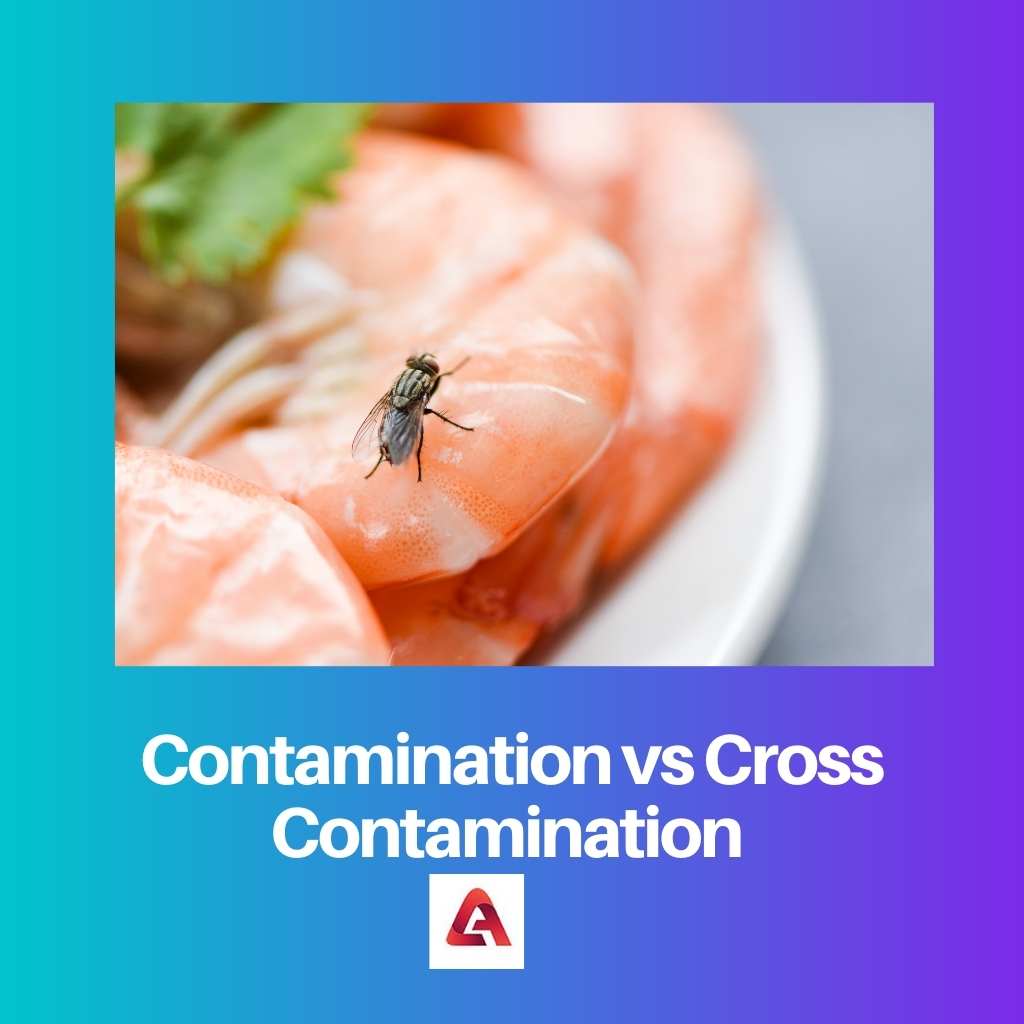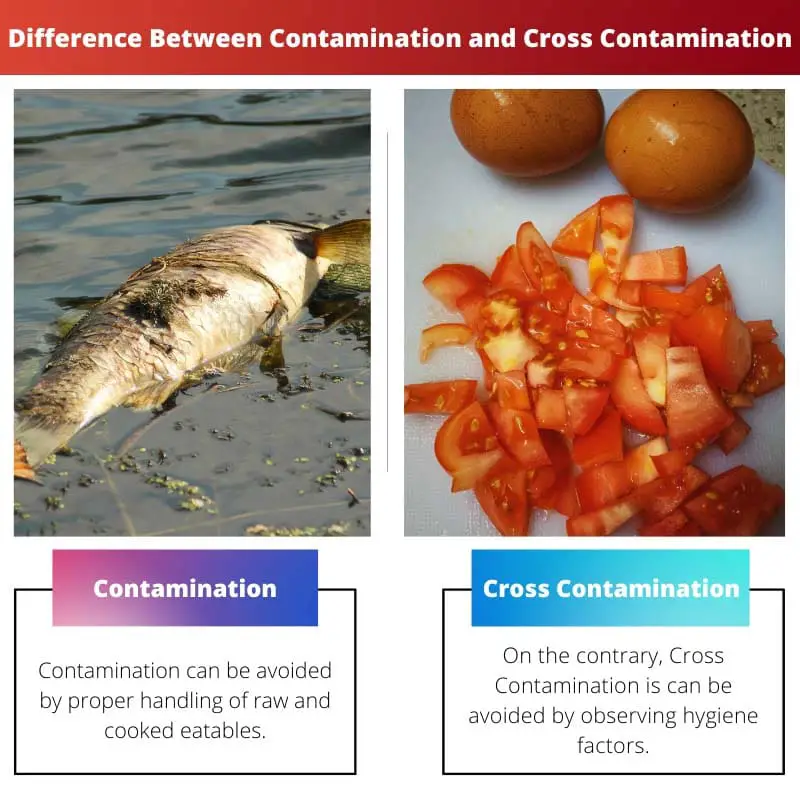Food is necessary for human survival on earth. Some unhealthy eating habits and improper dealing of food may lead to death.
Contamination and Cross Contamination are two terms that are neglected while preparation and storage of eatables that result adversely on our health.
Both processes attack our health in the same manner but from different sources.
Key Takeaways
- Contamination occurs when unwanted substances, such as bacteria or chemicals, are introduced into a product or environment. At the same time, cross-contamination happens when harmful substances are transferred from one item to another.
- Contamination can originate from various sources, including air, water, or soil, while cross-contamination occurs through direct contact or improper handling.
- Both contamination and cross-contamination can pose risks to human health and product quality, making proper sanitation and handling practices crucial for preventing illness and maintaining safety standards.
Contamination vs Cross Contamination
Contamination refers to the presence of harmful substances or pathogens in an environment, such as in food or water. Cross-contamination occurs when harmful substances or pathogens are transferred from one surface or source to another. It can also occur through contact with contaminated surfaces.

Contamination is a process of food spoilage, where the management and handling of food in an improper way leads to a dangerous impact on the human body.
Contamination in food can arise in numerous ways i.e. Chemical Contamination, Physical Contamination, and Biological Contamination. Covering the meals and washing the fruits and vegetables before intake are a few ways to minimize it.
Cross Contamination refers to the transmission of bacteria and allergic substances from food products and other objects. It occurs in food items containing allergens.
Kitchens of Hotels and Restaurants kitchens are prone to Cross Contamination. The consequences of Cross Contamination are toxic for human body parts.
For example, Raw meat containing pathogens are transferable to surrounding items.
Comparison Table
| Parameters of Comparison | Contamination | Cross Contamination |
|---|---|---|
| Precautionary Methods | Contamination can be avoided by proper handling of raw and cooked eatables. | On the contrary, Cross Contamination is can be avoided by observing hygiene factors. |
| The Reason Behind | Contamination is improper storage, management, and preparation of food. | Cross Contamination is allergen and chemicals used in food processing and manufacturing. |
| Contaminant | The contaminant is unknown in the case of Contamination. | The contaminant is familiar in the case of Cross Contamination. |
| Sources | The sources of Contamination are Airflow, equipment, kitchen tools, and cleaning issues. | The sources of Cross Contamination are space limitation, improper labeling, lack of attention, and lack of training. |
| Results | Contamination gives slow results. | Cross Contamination affects fast and provides quick results. |
What is Contamination?
Contamination is a severe public health issue around the globe. It results in food-borne health problems like stomach infection or food poisoning.
The main cause of Contamination in food is the presence of germs and bacteria in the eatables.
Food items will change the color, flavor, odor, or taste of the dish while spoiled from bacteria. A cooked dish can be contaminated again if come in contact with any raw item.
Hand Washing is a good habit to prevent unhygienic in cooking and eating.
Refrigeration and Cold storage also protect the multiplication of germs and bacteria in the food items through only visual bacteria can be minimized with it.
If we wash our fruits and vegetables with spoiled water or reused water that may lead to Contamination again.
Insecticides, herbicides, rodenticides, and other pesticides used in harvesting also lead to direct Contamination in food. Reduction of Contamination effect by sterilizing utensils and sanitizing kitchen tools from the outer area.
Fermentation or Rancidity will occur in Contaminated food. Meat and poultry can spoil other items present in the cooking area.
Covering the food with a lid or plate also protects from Contamination. Insects in the kitchen cause Contamination in raw food items to avoid the same organic pest control should be in place.
What is Cross Contamination?
Cross Contamination arises when one contaminated food item spoils another fresh food item by transferring the germs. For example, an infected sauce is consumed with a freshly prepared sandwich.
If an allergen-causing food is mixed with the raw food items in the kitchen that will give rise to Cross Contamination.
Workers in the food manufacturing unit if, do not follow cleaning habits will give rise to Cross-Contamination in food.
Following habits can reduce Cross-Contamination:
- Storing raw food and ready-to-eat foods separately.
- Ensure employees must be able to recognize and prevent cross-contamination situations.
- Ensure companies and factories have measures set up to reduce the likelihood of cross-contamination.
- To observe hygiene when handling food products.
Cleaning plays a crucial role in the prevention of Cross Contamination that arises from rapidly growing bacteria. Training should be in place to follow deep cleaning habits.
The side-effects of Cross Contamination are mild to severe on the human body. A few Side-effects are loss of appetite, stomach ache, headache, nausea, upset stomach, and diarrhea.
For better understanding, A Person making Pizza at the stall may transfer his bacteria into the dough, that is further consumed by us. One thing that is clear in the case of Cross Contamination is Food and eatables only.
Main Differences Between Contamination and Cross Contamination
- Meaning: Contamination is a general term where something is affected by a harmful element. On the other hand, Cross Contamination is a specific term where accidental harm occurs.
- Example: Contamination occurs when chicken blood spillage on the gas stove from the packet and Cross Contamination occurs when we touch the blood and further touch another substance in the kitchen.
- Definition: Contamination is the presence of microorganisms or foreign substances in food items. On the flip side, Cross Contamination occurs when a virus or bacteria is moving from contaminated surface to uncontaminated surface.
- Output: Contamination leads to food poising and Cross Contamination leads to incurable diseases in the human body.
- Prevention: Contamination can be prevented by washing and properly maintaining food items. On the flip side, Cross Contamination can be prevented with washing tools used in food preparation and maintaining hygiene.

References
- https://meridian.allenpress.com/jfp/article/53/3/202/195733/The-Impact-of-Commercial-Processing-Procedures-on
- https://www.science.org/doi/abs/10.1126/science.6451928
